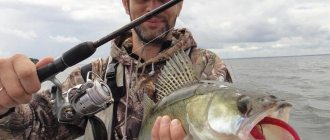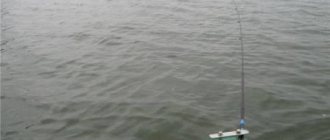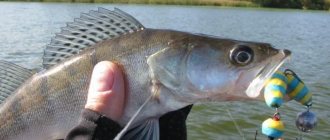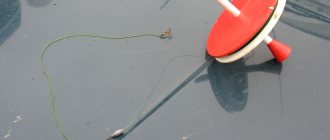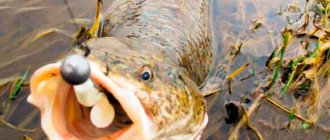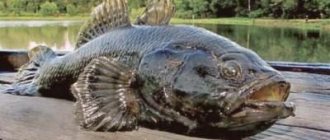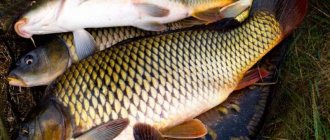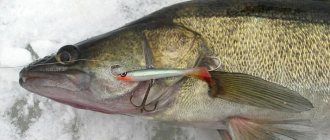Time for the leucorrhoea and the predator
Catching white fish, from about the third decade, fades into the background, especially as the water gets colder. But from the beginning of the month, as soon as the leaves begin to turn yellow, fishing continues successfully. The fish gather in schools and migrate to deep places, selecting holes suitable for wintering. Water and air temperatures drop, plants sink to the bottom, and water visibility and clarity improves.
River in October
From this moment on, the long-awaited meal of fish begins. However, not in all species and not at the same time. So, at the beginning of October, the feeding of asp and chub is already over. Ide, bream, crucian carp and carp are also gradually moving away by the middle of the month. This is especially noticeable with the onset of a sharp cold snap.
If the September Indian summer affects part of October, then the bite of most types of leucorrhoea persists until the warm weather changes. The evening and morning bite lengthens in time and shifts more and more towards the daytime bite. The small fish hatch periodically on quiet, calm days.
In dry, cold weather you need to look for peaceful fish at the bottom, at depth. On warm days, she comes out to the shallows to feed. It is on such days that the predator’s increased gluttony is observed.
Moreover, the feeding of pike, pike perch, and perch continues throughout the month, and with colder weather it intensifies even more.
This is explained simply: on stormy and cold October days, white fish are concentrated in holes at depth, and predators, on the eve of a hungry winter, continue to feed and, in search of prey, scurry around the reservoir, grabbing the first fish or bait that hesitates.
Where is the best place to fish with a float rod at the end of October?
If in the summer months float tackle can be used everywhere, then closer to winter at the end of October you should approach the choice of fishing spot especially carefully. This is facilitated by the fact that the fish, gathering in large schools, go to the depths to their wintering grounds, and sometimes it is not possible to throw float gear there. In view of this, when choosing a fishing location, you should focus on promising places where fish accumulate in the month of October. Such places are dams and dams at and near spillways. These waters are rich in oxygen and carry many food particles that attract fish and help concentrate them. You should also pay attention to coastal holes and pools, where fish also like to gather in anticipation of insects and their larvae that have fallen from coastal trees. If you have a boat, then you should pay attention to the remaining islands of aquatic vegetation, in which the fish feeds and hides from predators.
Gear selection
October is good for its versatility. For many lovers of this or that gear, mid-autumn provides an opportunity to unwind, do some good fishing and catch selected and varied fish. For convenience, a selection of effective gear in October for the most common types of fish in our reservoirs is presented in the table below “ Efficiency of gear in October ”
| Fish | Float | Donka/feeder | Spinning | Fly fishing |
| Pike | — | — | +++ | — |
| Zander | — | — | +++ | — |
| Perch | — | — | +++ | — |
| Asp | — | + | ++ | + |
| Chub | — | + | +++ | +++ |
| Ide | — | + | + | ++ |
| Bream | + | +++ | — | — |
| Carp | ++ | +++ | — | — |
| Roach | +++ | ++ | — | — |
| Dace | + | +++ | — | + |
Perhaps the information will be useful to someone. So, let's begin,
Spinning fishing in October
Spinning is the most effective tackle for fishing in October. You can catch the following types of fish with it:
- pike;
- pike perch;
- perch;
- asp.
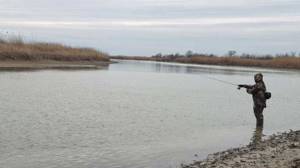
The effectiveness of fishing largely depends on the correct choice of artificial bait. October pike can often be seduced by a foam fish or a sinking minnow-class wobbler.
Read also: 10 best lures for pike
In October, pike perch responds well to jig types of bait made from “edible” silicone. The fanged predator weighing up to 2 kg prefers to attack twisters and vibrotails 10–13 cm long. Trophy specimens are more willing to bite on large baits, the length of which is at least 15 cm.
This is interesting: The best baits for pike perch
October perch can be seduced by small twisters and vibrating tails up to 10 cm long. Tail spinners, carried out at the very bottom with stepped wiring, also prove effective in fishing for a striped predator. The color of the bait is selected experimentally.
If in the summer and early autumn the asp more often attacked the bait moving near the surface, then in October it descends into the bottom layers. In such conditions, to catch it, compact jig-type spoons are used, which are guided in a stepwise manner.
Spinning in October: there are different fish
Float tackle
Successful fishing in October is determined by the correct choice of fishing location. And its search must be done from the standpoint of detecting fish migration paths into the pits. In October, the whitebait continues to feed, and if you can find parking and feeding areas for the school, you can catch quite a lot of fish.
The fishing rod is equipped with the usual equipment, fishing from the bottom, sometimes in mid-water. Animal baits, mainly bloodworms, worms, maggots, small baitfish.
Roach
The rod is 4-5 m long. The equipment must be sensitive. Line up to 0.14, leash - 0.12, float from 0.5 to 1.5 grams, hook size 14-18.

The roach hid
Fishing place:
- the reach right after the rift,
- the boundary of the direct jet and the suvodi,
- a grass edge with a sharp drop to depth.
Wiring at half-water. Bait is not necessary, but “proper fishing gurus” can use regular bream/crucian carp/roach. As we wrote above, it is much more important to find the right place.
Chub
At the beginning of the month, to catch chubs, the hook is baited with caddis flies and maggots, but as the weather gets colder, the bait changes. Small ones come to the fore, namely small baitfish - minnows. In some reservoirs, a small frog is used instead of a minnow.
Fishing location: deep places in front of and behind the riffles, under fallen trees, under bushes hanging over the water, behind the mouth of flowing rivulets, streams downstream.
They catch a chub using a line, and surround the float so that the bait floats 10-15 cm from the bottom. Skilled fishermen set up the gear to drag the minnow along the bottom. But beginners will most likely lose bait and catch the ground.
Rod from 4 m, fishing line 0.18-0.2 mm, leash 0.16-0.18, not bright float 3-6 grams. It should be noted that perch, pike perch and even pike can bite on live bait. Therefore, it is better to use a spinning rod with a reel as a fishing rod, and a 0.2-0.22 fishing line with a leash.
Who's getting caught
Fishing in October usually pleases with a variety of trophies. Fans of predator fishing feel this most clearly, but peaceful fish can also come across a wide variety of fish. The most common October trophies include the following types:
Pike
Perhaps this is one of the trophies for which people wait until the end of October. In autumn, this fish is most active, which is why it is caught everywhere and with almost any bait. At the same time, the average size of fish caught in October is much larger than in summer, and some trophies are truly amazing in their size.
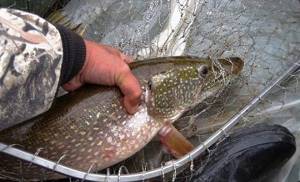
When catching trophy predators, you must have a landing net. This is especially true when fishing from a boat, since in this case the fish can not only fall off the hook or break the leash, but also go under the boat, break the rod or cut the bottom with a sharp angle of the equipment
Zander
The fanged owner of the rifts in October also does not refuse the offered bait. At this time, pike perch are already located in fairly deep sections of rivers and lakes, gathering in small schools. For this reason, having identified the place of one bite, it is sometimes possible to fish out several trophies from it.
Perch
In the fall, the striped fish also pleases the angler with its size. Trophy specimens hide in places typical for larger predators - deep holes and dumps, which is why it will be more effective to fish for them from a boat. In addition, in mid-autumn it often attacks uncharacteristically large-sized baits, which is why often when searching for pike or pike perch, the by-catch turns out to be a qualifying perch. It is also interesting that during this period the striped fish gives preference to stepped retrieves, even when it comes to spinners.

In the autumn, large perch rarely stay in schools together with small fish, which is why it is rarely possible to catch several humpback whales at once from one point. However, if you find a large deep hole stretched along the bottom of a reservoir, you can fully enjoy catching trophy striped
Bream
A typical October trophy. At the beginning of the month, it often bites on deep slopes and riverbed edges. In autumn, this fish prefers passive baits, which is why it is very important to keep your hooks statically in the feeding area. For this, fairly heavy sinkers and feeders are usually used. In addition to the worm, bloodworms perform quite well as bait for bream.
crucian carp
This fall, the fish beloved by many becomes capricious, and its bite becomes unstable. For this reason, you can go on a long fishing trip for crucian carp, and after several days return with nothing. However, you can often catch this fish quite successfully. As a rule, it stands at an average depth of 3–5 meters and begins to feed closer to lunch. Worms and bloodworms are used as bait. At the same time, it is important to use complementary foods more carefully than in summer, since in October the crucian carp eats much less, which means it is much easier to overfeed it.
Donka, feeder
Bream
Trophy October is no exception for bream. The autumn feeder is not much different from the summer feeder in setting up the gear. The fishing places are the same - river beds, bays, old men, but with a bias towards deep-sea fishing - in holes, exits from them, on dumps.
Groundbait with the addition of bloodworms, worms, maggots, broken shells, bait - animals, the same ones that we add to the groundbait.
If you don’t get a school of bream in the hole, you can catch a full cage of selected fish. This is a bonus of October fishing. As the temperature drops, it is the pits that are worth fishing.
They catch bream during daylight hours. The bite depends on the weather - on cold days it subsides, on warm days it becomes more active.
Carp
In October, carp fishing continues with donks and special carp gear - the fish are large, strong, and you won’t be able to get by with an ordinary float rod here. But the reservoir is different. On one lake the carp are active and feeding, as they say, in full swing, on the other they have already burrowed into hibernation.
In October, carp fishing depends on the activity of searching for fish and their sites. Search guidelines:
- driftwood, snags
- reed islands
- flooded trees
As the temperature drops, go deeper in the pits. Until the algae die off, the fish usually leads its usual life.
Bait for carp is mandatory, with a smell to attract it to the fishing site. Bait - special carp boilies, potatoes, corn, even a worm - depending on the reservoir.
Burbot
A strange fish, burbot, spawns in the cold winter, is caught on a dark, cold night, well, not like all “normal” fish. Indeed, burbot fishing begins in the second half of October.

Burbot at the bottom under the lantern
They choose a darker and colder night - there is a greater chance of returning with a catch.
They catch burbots with the simplest donks made of fishing line, sinker and hook, and feeder rods. The baitfish (brush or minnow) is caught by the lip; the predator does not care about the method of bait; if it bites, it will definitely swallow it. They throw it into the depths, into holes, under snags and wait. The bite is unnoticeable, the fish fishes out without resisting.
Dace
If in the first ten days of October the weather is favorable, without sudden pressure surges, the dace will peck and be caught. Donks and feeders need to be thrown over the riffle onto the river bed. Flocks of dace usually drift here at this time. In a good place, a good catch is guaranteed.
In principle, bait is not needed, but porridge with chopped worms and maggots will not be superfluous. The bait is a worm, bloodworm, and rarely maggot.
What can you catch with a float rod?
A float rod is one of the universal means of fishing; with equal ease you can catch peaceful fish such as roach, carp, carp, bream, white bream, rudd, bleak, and other species. The fishing rod can also be successfully used to catch predatory fish (after changing the equipment first). A float rod can easily bring a good catch of pike, perch, rotan, and ruff. It is also used to catch pike perch or asp, but it is still worth saying that this is more of a rarity than the usual use when fishing for these types of fish.
Subscribe to
our channel in Yandex Zen
Zherlitsy, mugs, live bait (video)
Pike, zander, perch
In October, live bait gear shows itself in all its glory. A greedy autumn predator, seeing a fish that is dying, staggering or twitching, will never let it pass, considering it an easy prey.
Mostly pike, pike perch, and less often perch are caught this way.
There is no point in retelling the devices and designs of these gears; they are publicly available on the Internet. Mugs are most often launched from a boat, live bait (line with or without a rod, float and hook with live bait) and girders (the same line with bait) are cast and caught from the shore. As live bait they take crucian carp, roach, ruffe, and minnows.
Fishing in October, autumn pike for mugs, video:
Spinning
Pike
Spinning pike fishing in the fall differs from other seasons in the use of large baits, from 10 cm. The probability of biting a trophy fish increases significantly. These will not be 2-3-year-old grasses, but a seasoned deep-sea predator.
The retrieve is slow and medium, usually near the bottom. But not always. You need to fish all horizons. Often fish, following small fish, rise from the depths on warm days and approach the shore.
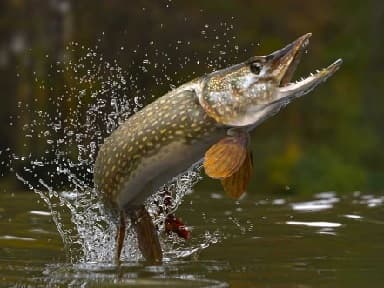
Predator hunting in October is not as pronounced hourly as in summer. When it gets colder, pike can feed and therefore be caught all day. Cloudy, even rainy weather may be more favorable for fishing.
The baits are different - from spinners, wobblers to jigs with rubber. Metal colors - silver, bronze, gold, rubber colors - light green, green, yellow with a black back.
Perch
As always, spinners, twisters, and jigs work great for perch. Of the rotating spinners, the classics are in the top: “meps” 1-2 numbers Aglia, Comet, AgliaLong and others. Twisters should be bright red, pink, acid green, yellow. However, if the perch is on the hunt, it will take everything...
Recessed wiring. The best way to fish the bottom is with a twister on a jig head. Then you can use the entire arsenal of perch baits.
In October you need to look for striped fish closer to the riverbed and at changes in depth, where it often hunts for small fish emerging from holes to feed.
Pike perch (video)
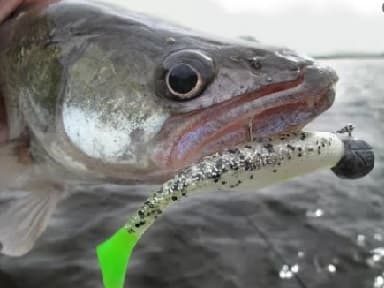
The best bait for pike-perch this month will be small live bait, small fish on a rig and rubber: a ripper, a vibrotail, and sometimes a twister on a jig head.
In October, walleye fishing is not much different from other open water calendar months. They catch the toothy one, like many predators in the depths. Driving along the bottom, with dragging and pauses.
Landmarks are whirlpools, near bridges, piles, driftwood and snags. In the deepest places of the reservoir.
Before wintering, pike perch gather in schools; it is quite possible to catch several worthy specimens from one place. It is good to fish the chosen fishing spot.
Fishing in October, catching pike perch with a jig, video:
Tackle
Fishing in October makes it possible to use a rich arsenal of gear, since at this time you can catch quite a large number of different types of fish, both predatory and peaceful. The main types of fishing allowed at this time are float, bottom and spinning. Accordingly, the gear used for fishing can also be classified into one of these categories.
Float
Fishing with a rod in October can hardly be called comfortable. In different regions at this time the weather changes in its own way, but they are all united by the fact that it deteriorates: rain, wind, and in northern latitudes, snow. In such conditions, the float actively plays on the water, creating difficulties in determining the bite in windy weather.
However, as you know, an experienced fisherman is not afraid of bad weather, and because of this, fishing in October with float gear can be very successful. In light winds, you can use a classic rig, but given the number of windless days this month, it is better to use a rig with an olive sinker.
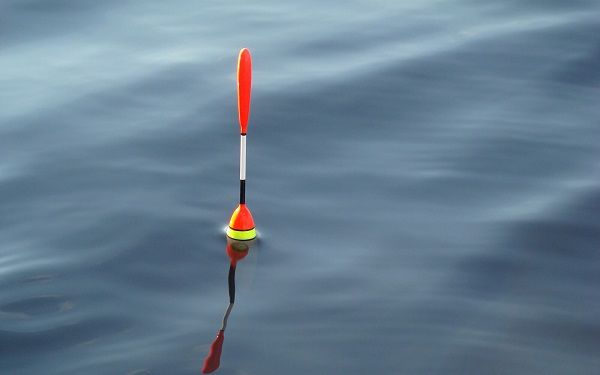
Fishing in October often takes place in strong wind conditions, which is why the float is constantly blown from its place, even despite the load. To reduce the impact of air currents, it is necessary to drown the section of the fishing line lying on the water, otherwise it plays the role of a sail.
What also speaks in favor of heavy loads is that in mid-autumn most fish migrate to fairly large depths, fishing at which involves not only delivering bait to holes, but also long-distance casting, which is difficult to do with a small sinker. For the same reason, fly rods give way to gear with reels in October - they can be used much more efficiently.
Important! The bait this month should also be different from the summer options. Since in October in most regions the fish begin their autumn feeding, during which they gain weight to survive in the winter, they become less interested in low-calorie foods, which they could easily be tempted to eat in the middle of summer.
At this time, worms and maggots should be used for peaceful species; to catch a predator, pieces of meat, fish, chicken skin, lard, fry and other various baits of animal origin should be used.
The use of bait is important. In October, fish actively move around the reservoir, which is why it is most effective for fishing with float rigs to feed the fishing spot in order to attract as much prey as possible to it. The content of animal elements in the bait is also very important during this period.
For fishing with a float, they mainly use ingredients that make the place attractive, but do not overfeed the fish, since the point is usually fed quite generously, and if there is a large amount of nutritious food, the prey simply will not respond to the bait on the hooks. For this reason, elements such as dry milk, powdered eggs or dried blood can be included in the bait - their aroma will attract the fish, but will not allow it to get enough.
Spinning
Catching a predator in the fall is practically a paradise for an angler, except for not the most pleasant weather conditions. Its activity, especially at the end of October and November, increases greatly. It begins to actively move in bodies of water in search of prey and attack almost everything that moves or looks edible. At the same time, he usually gives preference to larger and higher-calorie prey than in summer, which is why in October spinners should increase the size of the baits they use.
It is also important to take into account that mostly medium and small specimens move in the thickness and near the surface of the water, while real trophies when fishing with a spinning rod are best found in holes and pools at great depths. For this reason, in October the best choice would be to use a more powerful rod than in summer. Such a spinning rod is more likely to withstand the fierce resistance of a serious trophy and at the same time will perform better when using large, heavily loaded baits.
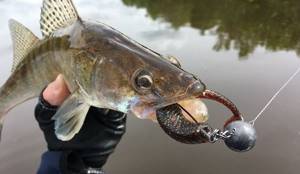
There are often precedents when even a not very large predator attacks a bait that barely fits in its mouth, so in the fall you should not be afraid to cut off medium-sized specimens with large bait
In terms of baits in the fall, a leader can be identified. Starting from October, jig dominates on reservoirs. Heavy weights and large silicone baits show their best side at this time, allowing you to catch both a mid-water predator moving in mid-water and trophies hiding at great depths, in holes and pools. The most effective in October will be the use of silicone baits with their own pronounced game - vibrotails and twisters. It is their vibrations that perform well when catching an active predator.
However, despite the effectiveness of jig rigs, those who like fishing with other baits will also not be left without bites - the predator in October, unlike peaceful fish, is not picky and often attacks everything that moves. For this reason, you can fish well both with spinners and spoons, as well as with wobblers, especially with greater depth.
Fly fishing
If in September the water allowed fishing with different flies, then in October it is noticeably cleaner and more transparent, placing increased demands on flies.
The basic rule is that the colder it is, the thinner the leader and the smaller the fly.
This situation makes both casting and landing fish more responsible, so where possible, it is better to fish with a streamer. The leash in the rig is more reliable here.
Among flies, preference is given to imitations of dipterans and small caddis flies.
Chub fly fishing (video)
If the first weeks in October are warm, chub can be caught using wet imitations of nymphs and subimagos. Interestingly, larger individuals are found at this time. As the weather gets colder, the bites at the surface stop.
Video of fly fishing for chub in October:
Ide
A more cautious ide will recognize a decoy in clear autumn water. It’s rare, but you still manage to catch him. The smallest wet ones are taken from the flies, including imitations of caddisfly nymphs, mayflies and stoneflies.
It bites only on warm days. The tackle must be designed for long casts, camouflage is necessary.
Well, that’s all, the big open water fishing season, as well as the fishing calendar of the year, is coming to an end. The last November trips to the water are ahead, and then winter and a trip to the ice. But that is another story.
About fishing in October
In October, the water temperature drops rapidly, which affects the fish bite in different ways. The activity of predatory representatives of the ichthyofauna is increasing. They try to accumulate more fat before winter and eat heavily. In this autumn month, the spinning angler’s chances of catching trophy fish increase dramatically.
As the water gets colder, peaceful species of underwater inhabitants reduce their feeding activity and move to deeper areas of the reservoir. This behavior of the fish forces the angler to be more attentive to setting up the equipment, choosing bait and bait.
If in summer the peak of fish bite occurred in the morning and evening hours, then in October it feeds throughout the daylight hours, taking a short break in the afternoon. On clear, windless days, fishing will be more successful than on rainy and windy weather.
